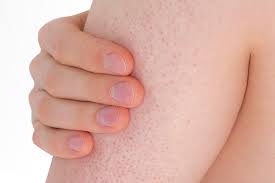
Got Scaly Skin Patches? Here’s Everything You Need to Know (and Do) for Softer, Healthier Skin
Scaly skin patches are more than just a nuisance—they can be uncomfortable, embarrassing, and sometimes even indicative of an underlying skin condition that requires professional attention. While dry skin is a common cause, not all dry skin is scaly, and not all scaly skin is simply dry. The difference lies in the degree of skin barrier damage, the presence of inflammation, and sometimes, even more serious skin diseases.
Board-certified dermatologists Hayley Goldbach, MD, and Melanie Palm, MD, MBA, explain that while many cases of scaly skin can be attributed to simple dryness, others are linked to chronic conditions like eczema or psoriasis—or even rarer disorders, such as cutaneous T-cell lymphoma or actinic keratosis, a potential precursor to skin cancer.
In this comprehensive guide, we’ll walk you through what causes scaly skin, how to identify different types of patches, when to see a dermatologist, and what you can do at home to restore your skin’s softness and smoothness.
What Exactly Is Scaly Skin?
Scaly skin occurs when the outermost layer of the skin—the stratum corneum—starts to shed abnormally. Normally, this layer sheds naturally and is replaced by new skin cells from below. But when the shedding process speeds up (or when the skin’s barrier function is compromised), the dead cells don’t fall off as they should. Instead, they accumulate, forming dry, rough, flaky, or thickened patches that may feel like sandpaper to the touch.
Depending on the underlying cause, scaly skin may also be discolored (reddish, pink, or brown), inflamed, itchy, or even painful.
Common Causes of Scaly Skin Patches
The list of potential causes of scaly skin is long and varied. Below are the most frequent culprits behind this condition, as well as some that are less known but important to recognize.
1. Dry Skin (Xerosis)
The simplest explanation for scaly skin is that your skin is extremely dry. This happens when your skin loses too much water or natural oils, causing it to become tight, itchy, and flaky.
Cold weather, low humidity, hot showers, harsh soaps, aging, and certain medications can all contribute to excessive dryness. In this case, the scaly texture is usually widespread and improves with consistent moisturization.
💡 Tip: If the scaly patches improve significantly after applying a thick, unscented moisturizer, then dryness may be the primary cause.
2. Eczema (Atopic Dermatitis)
Eczema is a chronic inflammatory condition that causes the skin to become itchy, red, cracked, and scaly. The patches can ooze or crust over in severe cases. Eczema often runs in families and can be triggered or worsened by environmental allergens, stress, diet, or irritants like soap or fragrance.
Dr. Goldbach explains, “With eczema, the skin barrier is compromised, making it more susceptible to allergens and irritants. Inflammation then leads to redness and scaling, especially on the hands, elbows, behind the knees, and around the neck.”
3. Psoriasis
Psoriasis is another inflammatory skin disorder, but it differs from eczema in that the skin cells multiply up to 10 times faster than normal. This rapid turnover leads to thick, silvery scales and red patches that are often itchy or painful.
According to Dr. Goldbach: “In psoriasis, the buildup of skin cells creates defined plaques with a characteristic white or silvery scale. These typically appear on the scalp, elbows, knees, and lower back.”
Psoriasis can be genetic and is often triggered by stress, illness, or injury to the skin (a phenomenon known as the Koebner effect).
4. Seborrheic Dermatitis
Often referred to as dandruff when it affects the scalp, seborrheic dermatitis can also occur on the face, eyebrows, ears, chest, and back. It causes yellowish or white flaky patches, often with redness and a greasy texture.
The condition is thought to be linked to an overgrowth of Malassezia, a yeast that naturally lives on the skin. It thrives in oil-rich areas, and its byproducts can cause an inflammatory response in some individuals.
5. Actinic Keratosis (AK)
Actinic keratosis is a precancerous skin lesion caused by prolonged sun exposure. These patches may feel rough, crusty, or scaly and are often pink or tan. While they can sometimes peel off on their own, they tend to return and may eventually progress to squamous cell carcinoma if left untreated.
Dr. Palm warns, “If you notice a persistent patch that feels different from the rest of your skin—especially one that peels and returns—it’s essential to get it examined by a board-certified dermatologist.”
What Do Scaly Skin Patches Look Like?
Although the exact appearance varies depending on the cause, there are some common signs to watch out for:
Color: May be white, silver, red, pink, or even brown.
Texture: Rough, dry, raised, or thickened.
Borders: Can be well-defined (as in psoriasis) or diffuse and irregular (as in dry skin or eczema).
Location: Varies depending on the condition. Eczema often affects flexural areas (like elbows and knees), psoriasis favors extensor surfaces, and seborrheic dermatitis prefers oily regions.
Sometimes the patches may itch or sting, especially if the skin is cracked or inflamed.
How to Treat Scaly Skin Patches
While some scaly skin patches can be managed at home, others require a professional diagnosis and medical treatment. Let’s break it down by levels of care:
🌿 At-Home Remedies (for Mild Cases or Dry Skin)
Use a thick moisturizer
Look for ointments and creams that contain ingredients like:
Ceramides (restore the skin barrier)
Hyaluronic acid (boost hydration)
Glycerin (draw moisture into the skin)
Urea or lactic acid (gently exfoliate and moisturize)
Avoid harsh products
Switch to fragrance-free, gentle cleansers and avoid alcohol-based skincare.
Humidifiers
If you’re in a dry climate or using indoor heating, adding moisture to the air can prevent skin from drying out further.
Gentle exfoliation
For dry skin buildup, exfoliate with soft washcloths or mild chemical exfoliants (e.g., lactic acid, salicylic acid), no more than 1–2 times per week.
💊 Medical Treatments (for Persistent or Moderate-to-Severe Cases)
Topical corticosteroids: Often prescribed for eczema or psoriasis to reduce inflammation and itching.
Calcineurin inhibitors (e.g., tacrolimus): Used as steroid alternatives for sensitive areas like the face.
Antifungal shampoos or creams: For seborrheic dermatitis, to reduce yeast overgrowth.
Phototherapy: Controlled UV light treatment can help certain chronic skin conditions like psoriasis.
Prescription retinoids: Useful for actinic keratosis and to encourage normal skin cell turnover.
Cryotherapy: Freezing off precancerous lesions like AK.
Biologic medications: For moderate to severe psoriasis, targeting the immune system.
🧠 Important: Never self-diagnose persistent scaly skin. Some dangerous skin conditions can mimic harmless ones. If your skin does not improve within 2–3 weeks of basic care, seek a dermatologist’s opinion.
When to See a Dermatologist
While many scaly skin issues are benign and manageable, you should book an appointment with a board-certified dermatologist if:
The patches persist beyond a few weeks despite moisturizing.
The scaling spreads or worsens.
There’s bleeding, cracking, or signs of infection.
The patches are painful or unusually colored.
You have a personal or family history of skin disease or skin cancer.
You’re not sure what the cause is and want an accurate diagnosis.
Final Thoughts: Getting Your Skin Back to Smooth, Healthy Condition
Dealing with scaly skin patches can be frustrating—especially when you’ve tried everything from lotions to lifestyle changes with no success. But the good news is that with the right diagnosis and treatment, most causes of scaly skin can be managed effectively or even resolved completely.
Whether it’s as simple as adding a rich moisturizer to your routine or starting a prescribed treatment for a chronic condition, the first step is understanding what’s going on with your skin. And for that, a dermatologist is your best ally.
So if you’re tired of hiding your dry, flaky patches or just want answers, don’t wait. Your path to soft, smooth, healthy skin starts with knowledge—and maybe a little professional guidance.


